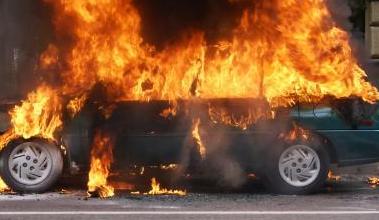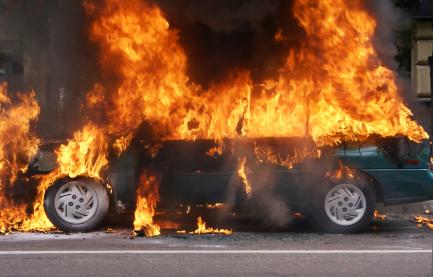 There were an estimated 194,000 highway vehicle fires per year in the U.S. from 2008 to 2010, causing approximately 300 deaths, 1,250 injuries and $1.1 billion in property losses, according to a recent report from the Federal Emergency Management Agency’s U.S. Fire Administration.
There were an estimated 194,000 highway vehicle fires per year in the U.S. from 2008 to 2010, causing approximately 300 deaths, 1,250 injuries and $1.1 billion in property losses, according to a recent report from the Federal Emergency Management Agency’s U.S. Fire Administration.
These fires accounted for 14 percent of fires responded to by fire departments across the nation and included cars, commercial trucks and off-road vehicles used on the highway.
The majority of highway vehicle fires, 86 percent, occurred in passenger road vehicles: 69 percent of highway vehicle fires occurred in standard passenger vehicles and another 16 percent occurred in some other type of passenger vehicle. Less than 1 percent occurred in buses.
Only 8 percent of highway vehicles occurred in non-passenger vehicles: 7 percent of vehicle fires occurred in transport vehicles, with freight road transport vehicles accounting for the majority of these fires. Less than 1 percent occurred in other types of vehicles such as construction vehicles, farm tractors and special purpose vehicles.
While highway vehicle fires occurred nearly uniformly throughout the year, the number of these fires was slightly higher during the months of June through August (28 percent). The report speculated that this slight peak could be due to elevated outdoor temperatures or increased vehicle use as many individuals and families take vacations during those months.
According to the report:
• Approximately one in seven fires responded to by fire departments across the nation is a highway vehicle fire. This does not include the tens of thousands of fire department responses to highway vehicle accident sites.
• Unintentional action (32 percent) was the leading cause of highway vehicle fires.
• Eighty-six percent of highway vehicle fires occurred in passenger vehicles.
• Sixty-one percent of highway vehicle fires and 35 percent of fatal highway vehicle fires originated in the engine, running gear or wheel area of the vehicle.
• The leading factor contributing to the ignition of highway vehicle fires was mechanical failure (44 percent).
• Insulation around electrical wiring (28 percent) and flammable liquids in the engine area (18 percent) were the most common items first ignited in highway vehicle fires.
The risks from motor vehicle fires are often overlooked. Toxic gases and other hazardous substances, along with flying debris and explosions, can combine to produce serious dangers. In the event of a motor vehicle fire, follow these important steps:
• Pull to the side of the road and turn off the ignition to shut off the electric current and stop the flow of gasoline. Do not open the hood or trunk if you suspect a fire under it. Air could rush into the area and enlarge the fire.
• Get out of and away from the vehicle. Never re-enter a burning vehicle to retrieve personal property.
• If the vehicle is in a garage or other structure, exit the building immediately.
• Do not put yourself in danger by trying to use a fire extinguisher. Only trained firefighters should extinguish vehicle fires.
• After you are a safe distance away, call 9-1-1 or your fire department’s emergency number.
Unintentionally caused fires accounted for 32 percent of highway vehicle fires. These fires may be the result of either careless behavior or accidental actions. Intentionally set fires constituted only 7 percent of highway vehicle fires.
Determining the cause of vehicle fires is often challenging. As a result, in 24 percent of highway vehicle fires, no cause was determined after investigation. The failure of equipment or the heat source was the cause in an additional 24 percent of highway vehicle fires. These fires are generally a result of mechanical problems, ranging from a faulty design in the vehicle to an improperly installed device
Mechanical failure or malfunction was the leading contributing factor to ignition of highway vehicle fires (44 percent). These mechanical failures include a leak or break in a component of the vehicle, automatic or manual control failures, or the use of an improper type of fuel.
An electrical failure or malfunction such as a short circuit was a contributing factor in another 22 percent of highway vehicle fires. The misuse of a material or product, such as spilling flammable liquid or gas too close to the vehicle, was the third leading factor contributing to the ignition of the fires (14 percent). These three leading contributing factors played a role in 81 percent of highway vehicle fires.
Less than 1 percent of all highway vehicle fires were fatal. Of the fatal highway vehicle fires, 89 percent resulted in a single fatality and 11 percent resulted in multiple fatalities.
Unlike all highway vehicle fires, fatal highway vehicle fires mainly occurred in the very late evening and early morning hours between 11 p.m. and 5 a.m. (40 percent). The highest percentages of deaths occurred between midnight and 1 a.m., 2 to 3 a.m. and 3 to 4 a.m. (each at 7 percent).
Like all highway vehicle fires, fatal highway vehicle fires occurred with little variation throughout the year, although a noticeable peak occurred in August (11 percent). Additionally, fatal highway vehicles fires occurred least often in May (6 percent).
Unintentional action was the leading cause, as it was for all highway vehicle fires, and accounted for 43 percent of fatal highway vehicle fires. In another 31 percent of fatal highway vehicle fires, the cause was still under investigation. The cause was undetermined in an additional 13 percent, while intentional action was the cause in 7 percent of fatal highway vehicle fires.
Where the information on the area of fire origin was available, 92 percent of fatal highway fires originated in the vehicle area and resulted in 92 percent of highway vehicle fire deaths.
The leading specific area of origin in both fatal highway vehicle fires and all highway vehicle fires was the engine area, at 35 percent and 61 percent, respectively. Fires that originated in the engine area were by far the deadliest, accounting for 34 percent of all deaths. Fires that originated in the fuel tank accounted for only 2 percent of all highway vehicle fires but 13 percent of fatal highway vehicle fires and 14 percent of deaths.
As for all highway vehicle fires, the leading sources of heat category for fatal highway vehicle fires with a known origin was “powered equipment” (44 percent) accounting for 42 percent of highway vehicle fire deaths. The leading specific heat sources for fatal highway vehicle fires were heat from miscellaneous powered equipment (20 percent), other miscellaneous heat sources (18 percent), and heat or spark from friction (16 percent).
Where the necessary data were available, the leading category of items first ignited in fatal highway vehicle fires was “liquids, piping, and filters” (60 percent), causing 65 percent of deaths. Flammable liquids and gases in general were, by far, the most deadly (63 percent of deaths).
Fuel in or from the engine area was the second leading item first ignited in all highway vehicle fires (18 percent) but was, by far, the leading item in both fatal fires (36 percent) and deaths (37 percent). Additionally, insulation around electrical wiring or cables was responsible for 28 percent of all highway vehicle fires but only 2 percent of fatal fires and 1 percent of deaths.
Collisions, as a factor contributing to ignition, resulted in 4 percent of all highway vehicle fires but were responsible for 57 percent of fatal highway vehicle fires. Fatal fires resulting from collisions accounted for 60 percent of highway vehicle fire deaths.
Determining the cause of death following a collision, however, can be difficult as the death may have been either the direct result of the collision or the fire that ensued. A fire fatality should be counted only if a person was trapped and killed by the fire, rather than killed on impact and subsequently exposed to the fire.
Unspecified mechanical failures contributed to 30 percent of all highway vehicle fires but are rarely fatal, accounting for 5 percent of fatal highway vehicle fires and 4 percent of deaths.












